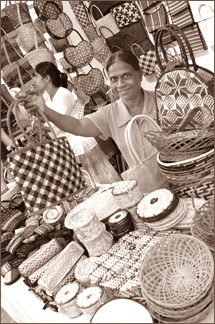|
Covers Uva, Southern , Sabaragamuwa provinces:
Gemi Diriya empowers rural masses
|

World Bank Country Directress Naoko Ishii |
The World Bank has approved a US$75 million IDA credit to Sri Lanka,
which will support the second phase of a community driven development
program that has touched the lives of nearly one million poor Sri
Lankans in the three provinces Uva, Southern, and Sabaragamuwa.
The Second Community Development and Livelihood Improvement Project,
known also as `Gemi Diriya’ or “the strength of the villages,” is active
in over 1,000 villages, helping communities identify, prioritize, plan,
fund, and implement their own development needs. About 870,000 people in
the most remote and poorest villages have benefited from community
infrastructure and productive investments such as drinking water, access
roads and bridges, ICT centres, access to credit, markets, skills and
income generation.
The second phase of Gemi Diriya will help expand its reach to two
more provinces (North Central and Central) and also broaden and deepen
the achievements to date.
It will especially focus on linking the community institutions to the
local governments and addressing accessibility and connectivity
constraints that hamper sustainable livelihoods.
 New to this phase is the support that Gemi Diriya will provide to two
major national programs - ‘Gama Neguma’ and Samurdhi - which are
adopting the community driven development approach and the local
governance systems of the project, specifically participatory
procedures, community contribution, devolving greater power to
communities and building a holistic village development. New to this phase is the support that Gemi Diriya will provide to two
major national programs - ‘Gama Neguma’ and Samurdhi - which are
adopting the community driven development approach and the local
governance systems of the project, specifically participatory
procedures, community contribution, devolving greater power to
communities and building a holistic village development.
“Despite an encouraging drop in poverty, considerable regional
disparities remain between the wealthier Western Province and the
lagging regions,” said Naoko Ishii, World Bank Country Director for Sri
Lanka. “Gemi Diriya has proven remarkably successful in empowering the
poor and raising incomes in some of Sri Lanka’s poorest provinces. Key
to its success is the focus on social services, skills development,
access to micro-finance for small businesses and micro-enterprises, and
partnerships with the private sector.”
To date, the program has financed 2,140 community infrastructure sub
projects, generated about 18,500 jobs, and provided livelihood
activities to 140,000 households. It has mobilized substantial resources
by promoting savings and village credit, and by linking communities to
financial institutions and private sector. The private sector now sees
village communities as an untapped supply source and consumer market.
Gemi Diriya has also been instrumental in forging partnerships between
the rural youth and key industries with employment potential, especially
textile, food retail and the ICT sector.
“The Gemi Diriya approach proved extremely successful in transferring
control over decision-making and financial resources to rural
communities, and in building community institutions that are empowered
and able to negotiate with the government and private sector on an equal
footing,” said Meena Munshi, World Bank team leader for the project.
“Our goal in the second phase of the program is for these community
institutions to graduate into federations to facilitate better market
and financial sector linkages, improving the delivery of livelihood
support services, and improving technology.”
Gemi Diriya is a 12 year program and is expected to benefit seven
million people in 5,000 villages by 2016. The World Bank supported the
first phase of the program with a US$51.0 million IDA grant. The credit
from the International Development Association (IDA), the World Bank’s
concessionary lending arm, has 20 years to maturity with a 10-year grace
period.
********
The second phase of Gemi Diriya will help expand its reach to two
more provinces (North Central and
Central) and also broaden and deepen the achievements to date.It will
especially focus on
linking the community institutions to the local governments and
addressing accessibility and
connectivity constraints that hamper sustainable livelihoods.
********
|

